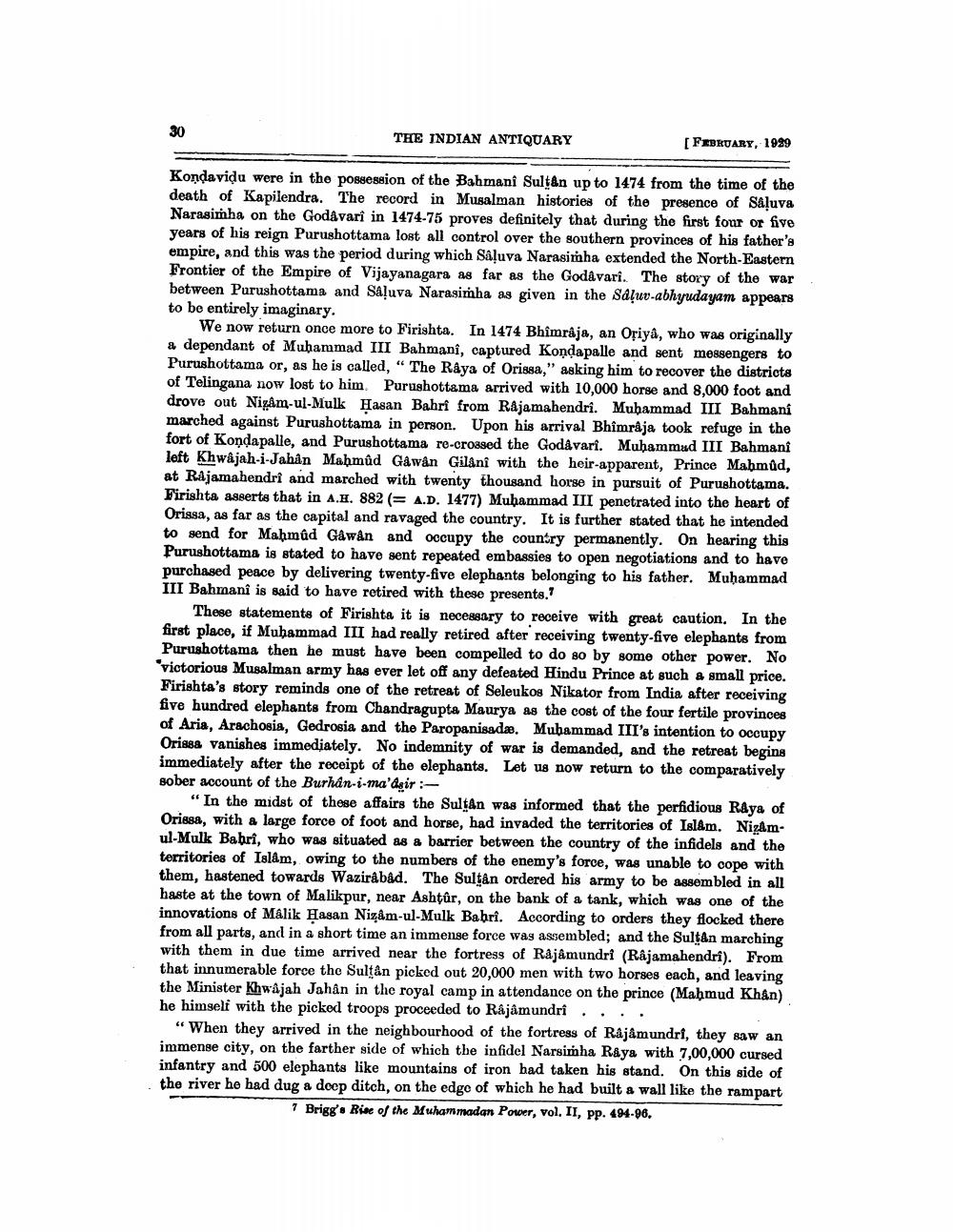________________
THE INDIAN ANTIQUARY
[ FEBKUARY, 1929
Kondavidu were in the possession of the Bahmani Sultan up to 1474 from the time of the death of Kapilendra. The record in Musalman histories of the presence of Såļuva Narasimha on the Godavari in 1474-75 proves definitely that during the first four or five years of his reign Purushottama lost all control over the southern provinces of his father's empire, and this was the period during which Saļuva Narasimha extended the North-Eastern Frontier of the Empire of Vijayanagara as far as the Godavari. The story of the war between Purushottama and Saļuva Narasimha as given in the Saļuv-abhyudayam appears to be entirely imaginary.
We now return once more to Firishta. In 1474 Bhimrâja, an Oriya, who was originally & dependant of Muhammad III Bahmani, captured Kondapalle and sent messengers to Purushottama or, as he is called, "The Râya of Orissa," asking him to recover the districts of Telingana now lost to him Purushottama arrived with 10,000 horse and 8,000 foot and drove out Nizâm-ul-Mulk Hasan Bahri from Rajamahendri. Muhammad III Bahmani marched against Purushottama in person. Upon his arrival Bhîmråja took refuge in the fort of Kondapalle, and Purushottama re-crossed the Godavari. Muhammad III Bahmani left Khwajah-i-Jahan Mahmûd Gâwân Gilani with the heir-apparent, Prince Mahmûd, at Rajamahendri and marched with twenty thousand horse in pursuit of Purushottama. Firishta asserts that in A... 882 (= A.D. 1477) Muhammad III penetrated into the heart of Orissa, as far as the capital and ravaged the country. It is further stated that he intended to send for Mahmûd Gåwån and occupy the country permanently. On hearing this Purushottama is stated to have sent repeated embassies to open negotiations and to have purchased peace by delivering twenty-five elephants belonging to his father. Muhammad III Bahmani is said to have retired with these presents.
These statements of Firishta it is necessary to receive with great caution. In the first place, if Muhammad III had really retired after receiving twenty-five elephants from Purushottama then he must have been compelled to do so by some other power. No victorious Musalman army has ever let off any defeated Hindu Prince at such a small price. Firishta's story reminds one of the retreat of Seleukos Nikator from India after receiving five hundred elephants from Chandragupta Maurya as the cost of the four fertile provinces of Aria, Arachosia, Gedrosia and the Paropanisadæ. Muhammad III's intention to occupy Orissa vanishes immediately. No indemnity of war is demanded, and the retreat begins immediately after the receipt of the elephants. Let us now return to the comparatively sober account of the Burhan-i-ma'asir :
"In the midst of these affairs the Sultan was informed that the perfidious RAya of Orissa, with a large force of foot and horse, had invaded the territories of Islam. Nizâmul-Mulk Bahrî, who was situated as a barrier between the country of the infidels and the territories of Islam, owing to the numbers of the enemy's force, was unable to cope with them, hastened towards Wazirabad. The Sultan ordered his army to be assembled in all haste at the town of Malikpur, near Ashtûr, on the bank of a tank, which was one of the innovations of Malik Hasan Nizâm-ul-Mulk Bahri. According to orders they flocked there from all parts, and in a short time an immense force was assembled; and the Sultan marching with them in due time arrived near the fortress of Rajamundri (Rajamahendri). From that innumerable force the Sultan picked out 20,000 men with two horses each, and leaving the Minister Khwajah Jahan in the royal camp in attendance on the prince (Mahmud Khan) he himself with the picked troops proceeded to Rajamundri ....
“When they arrived in the neighbourhood of the fortress of Rajamundri, they saw an immense city, on the farther side of which the infidel Narsimha Raya with 7,00,000 cursed infantry and 500 elephants like mountains of iron had taken his stand. On this side of the river he had dug a deep ditch, on the edge of which he had built a wall like the rampart
7 Brigg's Rise of the Muhammadan Power, vol. II, pp. 494-96.




